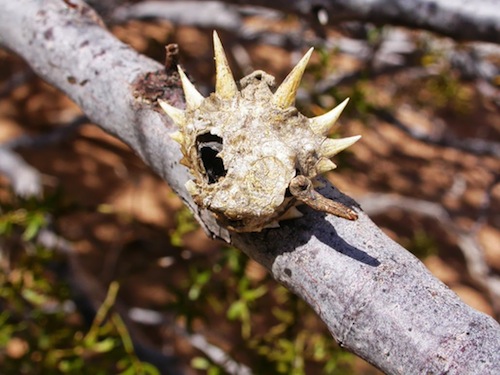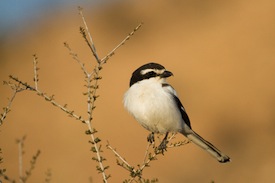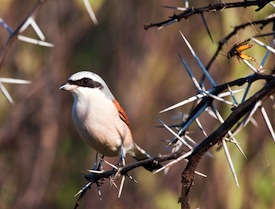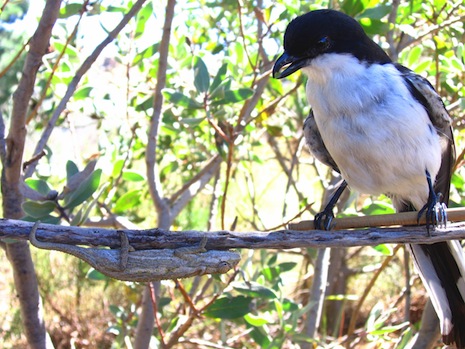 The remains of a horned lizard killed by a shrike.
The remains of a horned lizard killed by a shrike.
Wandering around New York’s American Museum of Natural History one day in May, I noticed a bird called the fiscal shrike. The small stuffed specimen, black with dashes of white on its wings, was perched on a shrub in a diorama of Kenya’s Kedong Valley. What an awful name for a bird, I thought. It sounded like a new budget-cutting initiative, or a particularly dire stage of an economic meltdown.
It turns out that “fiscal shrike” is not the worst thing this bird has been called*. One of its nicknames is “jacky hangman”; its genus, Lanius, is also called “butcher bird.” Germans have dubbed a related shrike species “Neuntöter,” meaning “murderer with nine victims.”

Why such grisly names? Shrikes are famous for their unsavory habit of impaling prey on thorns, twigs, barbed wire, or whatever other sharp object happens to be handy. Many of their smaller victims, such as insects, are spiked while still alive. The shrike then rips into the carcass with its beak, often devouring the head first.
Accounts of the shrike’s predatory practices read like something out of a horror movie. In a 1939 paper, one researcher describes a northern shrike that crushed an English sparrow’s vertebrae, speared the body on a sharp stump, and “pulled it with powerful jerks as if to make sure that it was well anchored, then began to eat it, tearing it into large pieces by seizing it with the hooked bill and jerking backward”. An earlier account, published in 1894, tells the tale of a shrike killing a meadow mouse “with admirable steadiness and coolness,” this time wedging the carcass into a forked branch. After eating its fill, the bird’s “forehead and throat were matted and soaked with blood, the breast was reddened perceptibly and the bill was almost wholly of a carmine tint.”

Some people have accused shrikes of impaling their victims out of sheer cruelty, especially since the birds sometimes do not even bother eating the spiked bodies. But James Whyte, a researcher from Houston, Texas, suggested another explanation in 1887. Since shrikes’ claws are not well-suited to ripping flesh, he wrote, driving a thorn through prey gives the bird “a greater purchase in tearing it to pieces”—rather like sticking a fork into a piece of steak. Another scientist, J.R. Watson, reported in 1910 that he saw a shrike in New Mexico eating the dried remains of lizards that had likely been skewered on a desert willow several weeks earlier. He hypothesized that this seemingly macabre practice allowed the meat to cure, similar to some people’s habit of hanging meat from a clothesline to dry it. And a study published in 1992 showed that loggerhead shrikes could eat normally-toxic grasshoppers by leaving them impaled for a day or two, enough time for the poisons to lose their potency.
Perhaps what has given this behavior evolutionary staying power, however, is its attractiveness to mates. A male shrike will build up a “larder” of spiked carcasses to entice females, sometimes decorating his grisly pantry with eggshells, sacs of feces, and bread crusts. The stored prey later prove useful for feeding the mother and her young. And researchers have found that males with bigger larders find partners earlier and produce more fledglings.

Shrikes also impale objects for less gruesome purposes. In Algeria, one scientist saw strings of dates on palm frond spikes that appeared to have been arranged by great grey shrikes, “rather like a cocktail sausage.” Other researchers have seen the birds use sharp objects to save or manipulate materials for building nests. One shrike, upon being offered a bit of wool, pinned it on a hawthorn bush; another pierced some twine with barbed wire and yanked off strands to use as nest lining.
So perhaps these birds might be better nicknamed “pantry stocker” or “nest hoarder.” But those don’t have quite the same ring as “butcher bird.”
Image credits
First image: Kevin and April Young
Second and third images: Shutterstock
Fourth image: Adnan Moussalli and Devi Stuart-Fox
* Some scientists have suggested that the fiscal shrike is actually two species, the northern common fiscal and the southern common fiscal.
Possessing the curiosity bug can be terribly time consuming!
Oooo, gruesomely awesome! Great post.
Thanks Cameron!